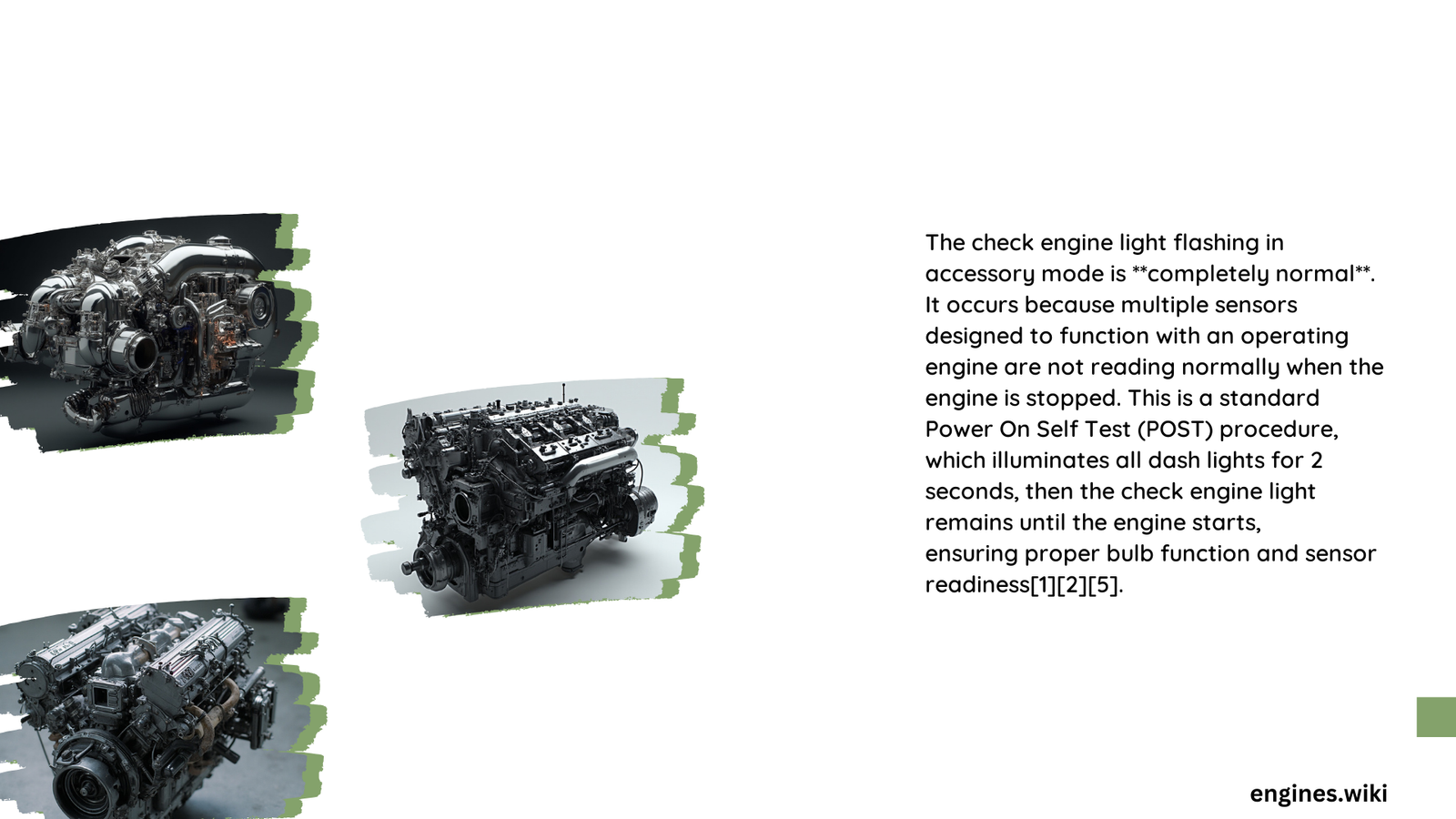A check engine light flashing in accessory mode typically indicates that the vehicle’s onboard diagnostic (OBD) system has not completed its required monitors or tests. This is often not a critical issue but can prevent the vehicle from passing emissions tests. The flashing light usually signals incomplete system readiness tests rather than specific fault codes. Common causes include recent battery disconnection, incomplete drive cycles, or potential sensor issues.
What Does a Flashing Check Engine Light in Accessory Mode Mean?
When your check engine light flashes in accessory mode, it’s usually not indicating a specific diagnostic trouble code. Instead, it’s signaling that the vehicle’s OBD system hasn’t finished its required tests. This situation often occurs after:
- Battery disconnection
- Recent repairs
- Extended periods of inactivity
The flashing light is the vehicle’s way of saying, “I’m not ready for an emissions test yet.”
Why Is My Check Engine Light Flashing in Accessory Mode?

Several factors can cause your check engine light to flash in accessory mode:
- Incomplete System Readiness Tests: The OBD system hasn’t finished all necessary tests to ensure emissions systems are functioning correctly.
- Recent Battery Disconnect: If the battery was recently disconnected, the vehicle’s computer may need time to complete its system checks again.
- Sensor or System Issues: While no codes are present, it could be a precursor to a sensor or system problem that hasn’t yet triggered a fault code.
How Can I Diagnose the Issue?
To diagnose a flashing check engine light in accessory mode, follow these steps:
- Use an OBD2 Scanner: Check for any fault codes, even if none are present.
- Check System Readiness Tests: Use the OBD2 scanner to verify if tests are incomplete.
- Complete a Drive Cycle: Allow the vehicle to run through a full drive cycle to complete all necessary tests.
- Inspect Sensors: Check and clean sensors like the throttle body and MAF sensor.
- Consult the Vehicle Manual: Refer to your specific model’s repair manual for guidance.
What Tools Do I Need for Troubleshooting?
To effectively diagnose the issue, you’ll need:
- OBD2 scanner
- Vehicle repair manual
- Basic toolkit
What Are the Implications of This Issue?
A flashing check engine light in accessory mode has several implications:
- Emissions Testing: The vehicle may fail an emissions test until all system readiness tests are completed.
- Performance and Safety: While not typically critical to immediate safety or performance, it can indicate underlying issues that need attention.
- Potential Future Problems: Ignoring the issue could lead to more serious problems if the underlying cause is not addressed.
How Can I Resolve the Flashing Check Engine Light?
To resolve the flashing check engine light in accessory mode:
- Complete Drive Cycles: Allow your vehicle to go through several complete drive cycles. This typically involves:
- A cold start
- City driving
- Highway driving
-
Idling periods
-
Check and Clean Sensors: Inspect and clean important sensors like:
- Mass Airflow Sensor (MAF)
- Throttle Body
-
Oxygen Sensors
-
Battery Check: Ensure your battery is in good condition and properly connected.
-
Professional Diagnosis: If the issue persists after these steps, consult a professional mechanic for a thorough diagnosis.
What Should I Do If the Problem Persists?
If the check engine light continues to flash in accessory mode after completing the above steps:
- Extended Drive Cycles: Some vehicles may require multiple drive cycles over several days to complete all readiness tests.
- Sensor Replacement: If a particular sensor is causing issues, it may need replacement.
- Professional Diagnostic: A mechanic can use advanced diagnostic tools to identify any underlying issues not apparent through basic troubleshooting.
Can I Drive My Car with a Flashing Check Engine Light in Accessory Mode?
Generally, a flashing check engine light in accessory mode doesn’t indicate an immediate driving risk. However:
- You may fail an emissions test
- There could be underlying issues affecting fuel efficiency or performance
- It’s best to resolve the issue promptly to prevent potential future problems
How Long Does It Take for System Readiness Tests to Complete?
The time for system readiness tests to complete varies:
| Driving Condition | Approximate Time |
|---|---|
| City Driving | 1-2 days |
| Highway Driving | 20-30 minutes |
| Mixed Driving | 1 day |
Note: These are general estimates and can vary based on vehicle make and model.
What Preventive Measures Can I Take?
To avoid future issues with your check engine light flashing in accessory mode:
- Regular Maintenance: Follow your vehicle’s recommended maintenance schedule.
- Proper Battery Care: Ensure your battery is in good condition and properly connected.
- Address Issues Promptly: Don’t ignore warning lights or unusual vehicle behavior.
- Quality Parts: Use high-quality replacement parts when repairs are necessary.
By understanding the causes and solutions for a check engine light flashing in accessory mode, you can effectively diagnose and resolve the issue, ensuring your vehicle remains in optimal condition and passes necessary emissions tests.
References:
1. Why Is My Check Engine Light On? – Read All About It
2. Service Engine Soon flashing 5 times when car is on ACC, but no codes.
3. Flashing Engine Light (Engine Off – Run Mode)
